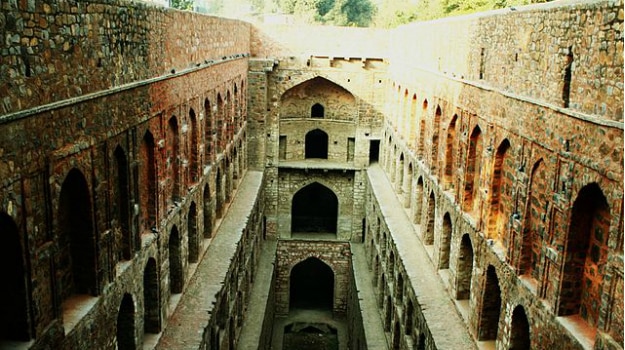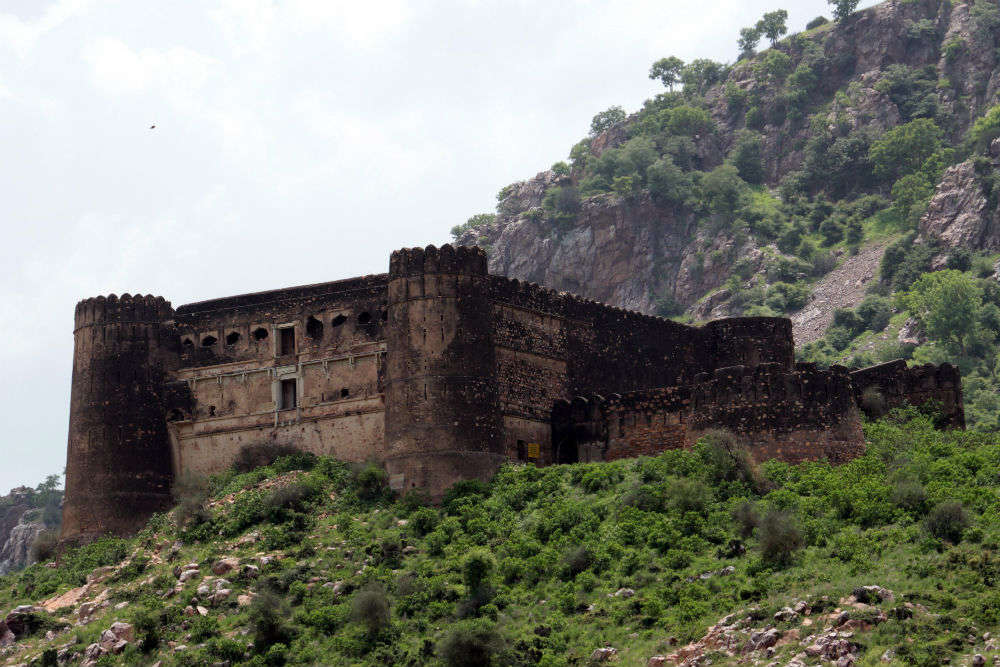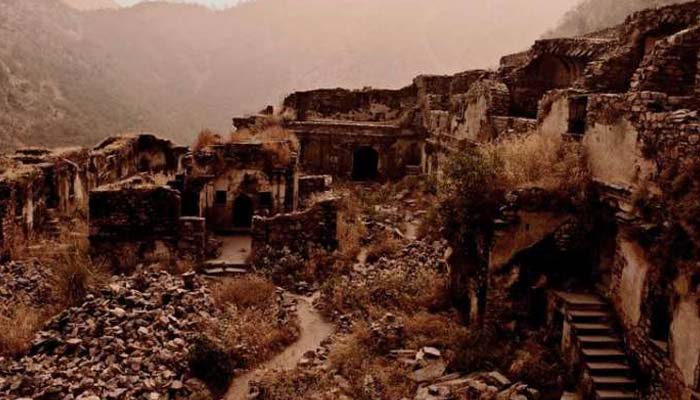1) IN DELHI:
A) AGRASEN KI BAOLI:
Agrasen ki Baoli, designated a protected monument by the Archaeological Survey of India (ASI) under the Ancient Monuments and Archaeological Sites and Remains Act of 1958, is a 60-meter long and 15-meter wide historical step well on Hailey Road,[1] near Connaught Place, Jantar Mantar in New Delhi, India.[2] Although there are no known historical records to prove who built Agrasen ki Baoli, it was originally built by the legendary king Agrasen,[3] and the present architecture hints at it being rebuilt in the 14th century during the Tughlag period of Delhi Sultanate. The Baoli is open daily from 9 AM to 5:30 PM.
Agrasen Ki Baoli, New Delhi: A 60-meter long and 15-meter wide historical step well in Delhi, it is considered by believers as haunted.
B) BHULI BHATIYARI KA MAHAL:
Bhuli Bhatiyari Ka Mahal, Karol Bagh: Ruins of a 14th-century hunting lodge that is believed by some to be haunted. It is situated in the busy market of Karol Bagh. A huge statue of Lord Hanuman can be seen on the road which serves as a landmark in Karol Bagh. People identify the nearby areas from the statue. Bagga Link is adjacent to this statue and behind this Bagga Link there is a silent road which takes you to the Southern Ridge of Delhi. Bhuli Bhatiyari Ka Mahal was built by Firuz Shah Tughlaq in the 14th century. Sources say that it was basically a hunting lodge during the reign of Firuz Shah Tughlaq. The entrance of Bhuli Bhatiyari Ka Mahal is made up of stones and a big gate can be noticed in the front. And there is another small door which ends into a big open courtyard.
2) GUJRAT:
A) DUMAS BEACH:
Dumas Beach is an rural beach along the Arabian Sea, located 21 kilometers (13 mi) southwest of the City of Surat in the Indian state of Gujarat.[1] It is a popular tourist destination in South Gujarat. Dumas Beach is justly famous for being in the top 35 haunted spots in India.
Haunted Dunas Beach
According to folklore, the legend of the beach being haunted is thought to be rooted in the widespread belief by locals that the beach was formerly a burial ground and is also attributed to the black sands and isolated location of the beach.[4] Most of the reports of supernatural occurrences on the beach remain unproven and unverified and might be an urban legend so far.
3) MAHARASTRA:
A) BRINDABAN SOCIETY:
Vrindavan Society (or Brindaban Society) is a large residential complex in Thane, Maharashtra, India, developed by a venture of Mittal and Raheja Developers.
B) SHANIWAR WADA, PUNE:
Shaniwar Wada, Pune An 18th-century fortification in the city of Pune, built in 1732 as the seat of the Peshwa rulers of the Maratha Empire until 1818, when the Peshwas lost control to the East India Company after the Third Anglo-Maratha War. The fort is said to be haunted by the ghost of the fifth Peshwa Narayanrao, who was murdered in 1773, by guards on orders of his uncle Raghunathrao and aunt Anandibai.
2) RAJASTHAN:
A) BHANGARH FORT:
Bhangarh Fort is one the most famous Haunted place in India. Bhangarh Fort, Bhangarh: Bhangarh in Rajasthan was purportedly brought to ruin as a consequence of the curse of Baba Balanath. Another legend attributes it to the curse of the sorcerer Singhiya. Entering the site before sunrise and after sunset is not allowed.
According to legend, a sadhu named Baba Balak Nath lived within the fort area, and it was his injunction that any house built in the precinct of the fort should not be taller than his own, and if the shadow of any such house fell on his, it would result in destruction of the fort town. According to another tale, a wizard adept in black magic named Sinhai fell in love with Ratnavati, a beautiful Bhangarh princess with many suitors. One day, the wizard followed her to the marketplace and offered her a love potion; however, she refused it, throwing it onto a large rock that consequently rolled onto the wizard and crushed him to death.
B) KULDHARA:
Kuldhara A site in Jaisalmer district, once a prosperous village inhabited by Paliwal Brahmins from 13th to early 19th centuries. Local legends hold that the Paliwals cursed the village with a haunting to frighten anyone who tried to occupy it. A 2010 film "Kaalo" is said to be loosely based on this place. .The film was disaster on box office. The local residents around the area do not believe in the legends, but propagate them for tourism. The Indian Paranormal Society's Gaurav Tiwari believes the village is haunted.
5)TELANGANA:
A) GOLCONDA FORT, HYDERBAD:
Golconda Fort, also known as Golkonda (Telugu: "shepherds' hill"), is a fortified citadel and an early capital city of the Qutb Shahi dynasty (c. 1512–1687), located in Hyderabad, Telangana, India.
Golconda Fort, Hyderabad A citadel and fort west of Hyderabad, Telangana that served as the capital of the medieval sultanate of the Qutb Shahi dynasty (circa 1518–1687). It is reported by believers to be haunted by ghosts of soldiers as well as the specter of a dancer named Taramati, who was one of the most famous courtesans of the said dynasty. The sound of her ghunghroo can be heard sometimes.
B) RAMOJI FILM CITY, HYDERBAD:
Ramoji Film City is an integrated film studio complex located in Hyderabad, India. Spread over 1,666 acres, it is the largest integrated film city in the world and as such has been certified by the Guinness World Records as the largest studio complex in the world. It was built by Telugu film producer Ramoji Rao in 1996. The Guardian described Ramoji Film City as "city within a city
In the many actors and other members feel the some unnatural incident and hence this film city is one of the most famous for its Haunted stories and its own mystery. It is also a popular tourism and recreation center, containing natural and artificial attractions including an amusement park. Around 1.5 million tourists visit this place every year.
6) UTTARAKHAND:
A) SAVOY HOTEL, MUSSOORIE:
The Savoy, is a historic luxury hotel in the hill station, Mussoorie, in Uttarakhand state of India, owned by the ITC Hotels. Established in 1902, built in English Gothic architecture style mostly in wood, the hotel is spread over 11 acres (45,000 m2) with 50 rooms at present, and overlooks the Himalayas. After the railway reached Dehradun in 1900, Mussoorie became more popular, and was the chief summer resort for European residents of the British Raj, from the plains of the United Provinces. Its bar, known as the 'Writer's Bar' remained famous for many decades after the independence of India in 1947.
Savoy Hotel, Mussoorie The ghost of Lady Garnet Orme is said to roam inside the hotel searching for her murderer. It is said that Orme was murdered by mixing a rodent killer in her food. Her doctor was found dead under suspicious circumstances after that. If you ask the locals about the way to the hotel, you may see a weird expression on their face too. Now a days this hotel has been reconstructed by ITC Limited and no ghost sightings have been reported.



















0 comments:
Post a Comment